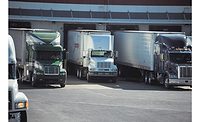Supply chain disruptions giving the food and beverage industry food for thought

The ongoing supply chain problems have multiple causes, including labor, transportation and container shortages.
Photo credit: Getty Images/xavierarnau
We have never heard the phrase “supply chain” as much as we have in the previous couple years. Far from being the preserve of logistics specialists, it’s entered our everyday vocabularies and made headlines across the world.
This is because supply chain issues have touched multiple aspects of people’s lives, from topping up at filling stations to buying staple food items. Companies around the globe have also been affected—some more fatally than others.
The ongoing supply chain problems have multiple causes, including labor, transportation and container shortages. Of course, inflation has been rising, around the world, for some time. Yet supply chain issues really went into overdrive when COVID-19 hit.
Winners and losers
The first modern pandemic threw up plenty of surprises for businesses. While consumer demand in some sectors soared, in others it disappeared—often unpredictably. This saw forecast planning error increase by 59% on pre-pandemic levels, according to a study by E2open.
In the food and beverage industry, the grocery sector benefited from people cooking at home and taking up hobbies like baking. Plus, bouts of panic buying saw the Bullwhip Effect (Forrester Effect) come into play.
Shuttered restaurants, meanwhile, stopped their orders entirely. The situation for dining establishments picked up a little while into the pandemic, with QSR restaurants doing best and other businesses adapting to offer take-outs.
Yet even before the pandemic started, labor shortages—primarily due to low pay—were causing problems in the F&B industry, particularly in packing plants, processing areas and trucking. As the tide of COVID-19 infections began rising, absenteeism and the need for social distancing only compounded the issue.
Delays by sea
In today’s globalized F&B world, companies often cherry-pick the most useful ingredients from overseas, whether it is a specific additive to keep bread fresh or a particular emulsifier for mayonnaise. When such ingredients are delayed by supply chain problems, production is held up.
Of course, delays have a way of multiplying, resulting in huge backlogs of cargo. Delays at the port of Los Angeles were so bad in late 2021 that President Biden made an announcement that it would remain open 24/7. Labor shortages at North American ports have exacerbated matters and the US diverted some ships to east coast ports.
Shipping container shortages and packaging problems
When ships are gridlocked, what becomes of the containers they carry? What happens when they’re stuck halfway around the world for weeks?
There’s currently a pronounced container imbalance, with empty containers stuck at US ports and a shortage being experienced in China. This is partly due to manufacturing disruptions and partly caused by the US importing around three times more goods than it exports to China.
The result is not just lengthier shipping times; costs have also risen dramatically. A container might now cost $5,000 to $25,000—10 times more than they normally would.
The container imbalance has also created packaging issues for manufacturers. Materials like Styrofoam are needed by meat producers, while films are used to package all kinds of foods. When most of these materials arrive from overseas, production is held up even when the food products themselves are ready for consumers. Some packaging producers overseas have even suffered power outages due to stricter regulations around coal usage.
Human actions
People are often the least predictable of all factors, as shown by Vladimir Putin’s decision to invade Ukraine. The effects on the global F&B economy have already been profound, with soaring oil and gas prices affecting manufacturing, transportation and agricultural supply chains.
Then there’s the role of Russia and Ukraine in food and fertilizer production to consider. Supplies of wheat, sunflower oil and corn are low, which could have particularly serious consequences for food security in Africa. By blocking Ukrainian grain exports from leaving Black Sea ports, Russia is pushing the global price of the commodity up. The same goes for fertilizer, with producers of phosphates, potash and other fertilizers reliant upon supplies of raw ingredients from Russian and Ukraine.
Meanwhile, food supplies in Canada were deeply affected by blockades on the US-Canada border, launched in protest at Canadian quarantine policies for truckers not fully vaccinated against COVID-19. During the winter, Canada imports up to 90% of its fruit and vegetables from the US, meaning border delays lead to supply shortages in grocery stores.
Lean on your systems
When uncertain times come along and swift adaptation is called for, it pays to have effective product management and development processes in place. Then you can continue with your core offering, while creating new products to meet new demands.
For manufacturers, the number of SKUs may have to be reduced while priority is given to production of main ones in the short term. Retailers may find it necessary to widen out their supplier base or change formulas in the face of supply chain problems. They might even need to reduce their product ranges if manufacturers reduce production.
For F&B brands, retailers and manufacturers, having visibility of their supply chains is a necessity. As well as providing transparency on that front, a modern product lifecycle management (PLM) system simplifies product lifecycles, bringing all product data and workflows together into one place. Equipped with the necessary information, businesses can then react to rapid market changes.
To meet shifting consumer demands, F&B companies must innovate and create new products. If they can do so with shortened product timelines, they’ll be able to jump on trends while they’re still on the way up.
Digital Demands
With so many factors causing supply chain disruptions and uncertainty, the F&B industry needs to shield itself from future surprises. One of the best, most proactive ways to do this is through tools such as PLM, which can help businesses respond to—and capitalize on—new consumer demands. Embracing digital transformation will not only alleviate current and future supply chain issues, it will also set businesses up to thrive.
Looking for a reprint of this article?
From high-res PDFs to custom plaques, order your copy today!





